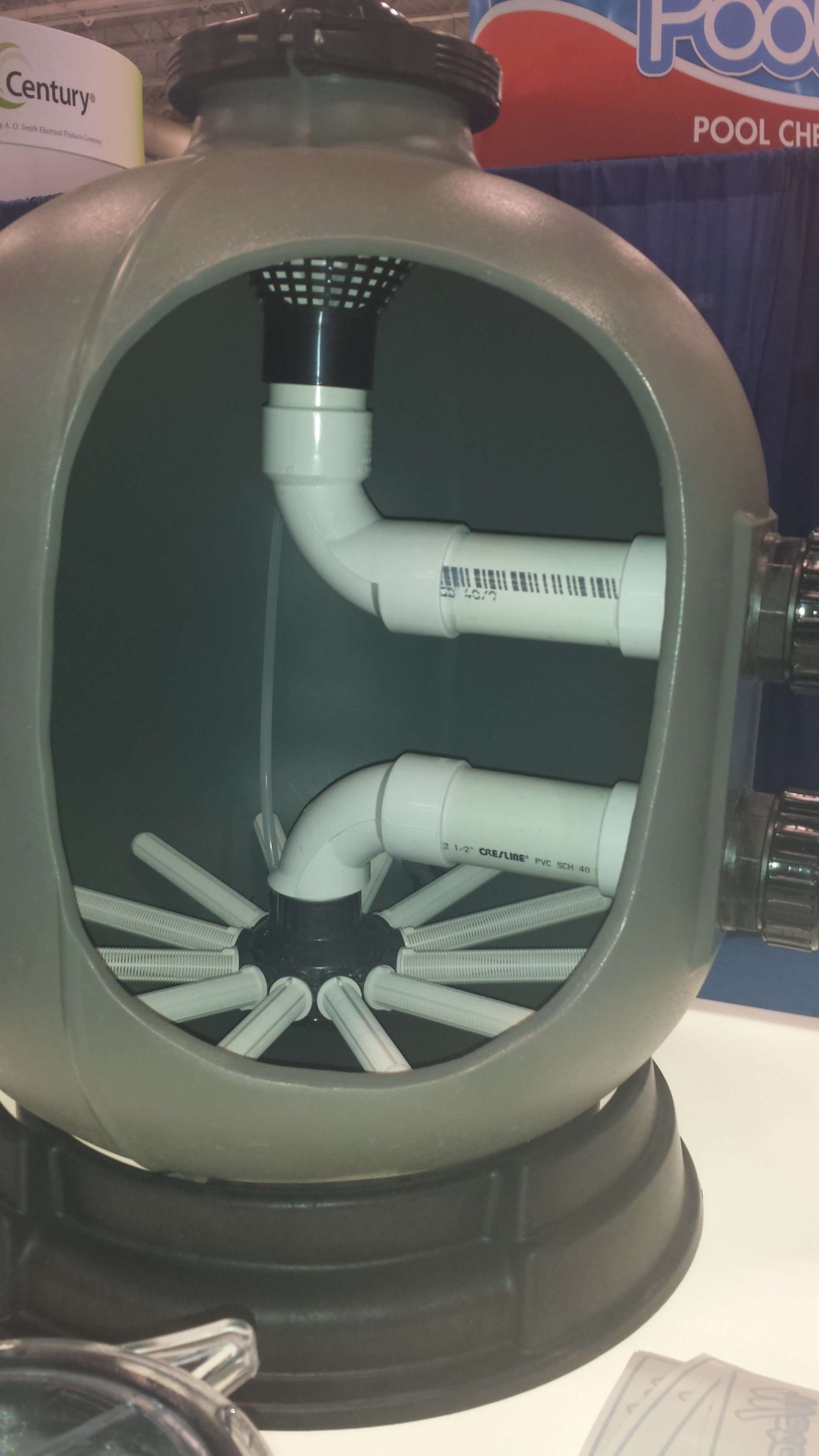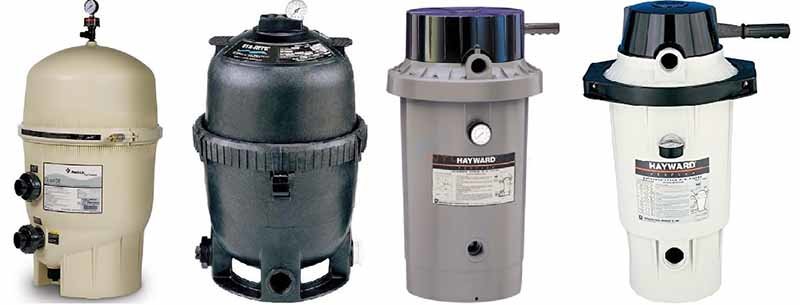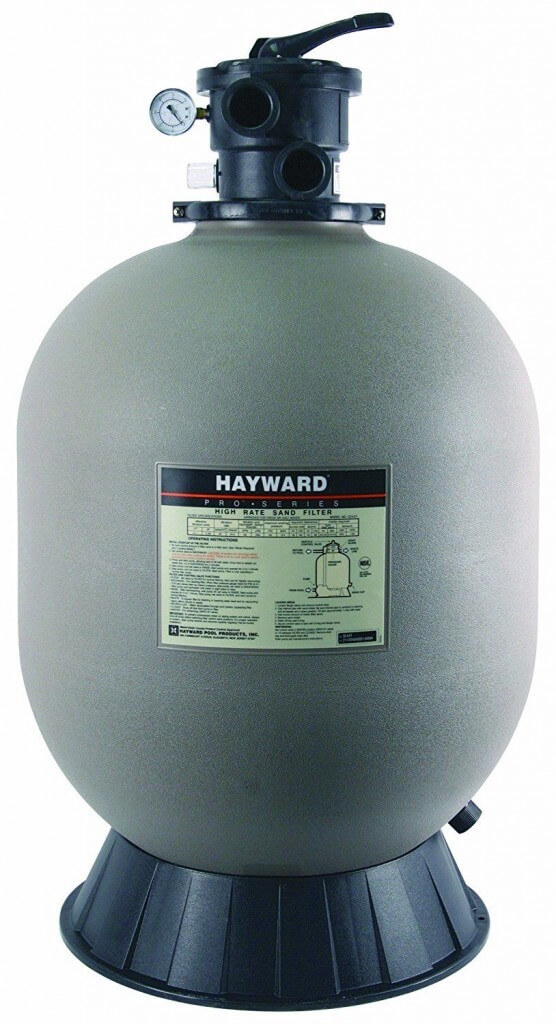Swimming pool filter information to help you choose what type and size are best for you.
There are pool filter reviews all over the web with a clear marketing agenda and written by people with no experience. Here I have written the facts and offered my 30 years experience to help you.
It is not a matter of opinion when comparing pool filter types. Of the just three kinds available, there is no arguing the fact that Diatomaceous Earth (D.E.) does the best job of filtering and cleaning water. D.E. filters are able to remove the smallest particles of dirt from water (fact).
For those more interested in just Above-Ground Pool Filters, I have a new article. Click Here
The only other two filter types are Cartridge, and Sand. Again, it is not a matter of opinion, Cartridge filters do the next best job, and then Sand is worst. There are, however, some pros and cons of all three types of filters. While all will keep the water clear, one is most expensive, A couple easier to maintain, and one is better for the environment, while another cost the least.
When you are finished with this short post, you should be able to select the pool filter that is most appropriate for your circumstances. Also, I will share my opinion, explaining which specific filters are best for cleaning and maintaining residential inground and above-ground swimming pools, all without your eyes glazing over (hopefully). Lastly, I tell you what I would use and why
Filter Types & Efficiency: Sand, D.E, & Cartridge
Sand Filters
Sand is the oldest and most economical choice. Sand is, however, the least efficient without the use of flocculant or filter aids. Filter aids will shorten the life of the sand or cause channeling. Sand filters are only able to grab particles of 40 microns. As a point of reference, a grain of table salt is about 100 microns; a human hair is about 75 microns. With good eyesight, you can see a 40-micron particle (dirt). Any particles smaller than 40 microns will pass through the filter and come back into the pool.
Today’s residential sand filters work by evenly distributing unfiltered pool water across the top of a bed of sand in the pool filter (white silica preferred). The pump pressure pushes the water down through the sand to the bottom, where the now filtered water flows through piping called laterals. Laterals have small holes that let the water pass but keep the sand in the filter. The filtered water then goes back to the pool (filtered down to 40 microns).
Pool dirt accumulates in the top of the filter on top of the sand, with enough debris on it, the water gets harder to push down, and tank pressure rises (this is why you have a gauge). When water-pressure increases 7-10 psi, you backwash out the dirt.
PRO Tip* Don’t buy a sand filter, but if you do, go big on the filter size and low on the pump pressure. Best to run a 2-speed or variable-speed pump on low for 24 hours, then a single speed on high for 8 hours.
Buying Tip* It is the sand that cleans the water, not the name of the filter. So, just buy a cheap no name filter and put in a good filter sand, like white silica filter sand, available at most pool stores.
Pro’s
Sand filters are the least expensive. They require the least amount of maintenance and are a snap to winterize. Sand media lasts 5 to 7 years. They all have a backwash cycle, so no need to get dirty cleaning the filter. Sand filters date back to 1804 when they were first used to purify water. These are an excellent choice for nonbackyard enthusiasts or those considered not “particularly handy.”
Con’s
Sand filters are the least efficient, so getting dirty pools clean takes longer. Not appropriate for super dusty areas like Arizona, and require long backwash cycles for cleaning. Backwashing wastes a lot of water. You may need to run the filter longer to clear pools in high pollen areas. Longer run times means higher energy bills.
Channeling is another concern; it occurs when pump pressure is excessive, causing channels to form between the top and the bottom of the filter. The water follows the easy path instead of evenly filtering down through all the sand. Filter aids such as flocculant/flox can also cause channeling.
With its inability to catch small debris, small bits of algae are allowed to pass through the filter and take hold, versus getting filtered out as it would in either of the other two filter types.
Cartridge Filters
Cartridge filters are the newest type of pool-filter and are the second best with its ability to grab particles @ 15 -25 microns.
These fiber filter types have become extremely popular in the past few years, especially with above-ground swimming pools. Water enters the filter housing delivered from the pump; water is then forced through the porous fiber cartridge material, trapping all particles larger than 15-25 Microns on the surface of the filter cartridge. Once the water makes it to the inner core, the then filtered water gets directed back to the pool.
Used in many industries including water purification for drinking, hot tubs and more. The quality of the filter is determined by the density of the pleats on the cartridge, as well as how deep the cartridge pleats are.
It is best not to oversize the pump when going with a cartridge filter. High water volume can beat up the filter element, and require it to need replacing earlier than usual. High volume pumps, with high HP (horsepower), run at full speed, will also embed dirt into the filter fibers, or cause blow-by. Always best to run pumps on low, even if it extends the run cycle.
Buying Tip* Remember it is the cartridge that cleans the water. You can buy a Unicel cartridge-filter for the cheapest cartridge filter on the planet, and it will clean the water as good as the best brands like Pentair or Hayward.
Cleaning Tip* There is only one tool made and designed for cleaning a cartridge filter, it is called the Aquacomb. It makes cleaning the filter a much quicker. For the best results use a spray on cleaner like BioGuard, it will help clean off suntan lotions and other hard to remove debris. Read our article on Pool Cartridge Filter Cleaner for more info.
Pro’s
Cartridge filters are more efficient than sand. Require a lot less water to clean. These are the most environmentally friendly option.
The cost has come down considerably lately, so they don’t cost that much more than sand, and still much less than DE.
They take up less room and are capable of cleaning large pools
Con’s
An over-sized pump will embed dirt into the filter, and the high pressure will beat up the fibers, requiring the cartridge to need replacing more often. I recommend a 1 HP or even a .75 HP pump, or at least a two-speed pump ran on low speed.
Lacking a backwash cycle like the other filter types, you have to disassemble the filter every time the cartridge requires cleaning.
D.E. Filters
D.E filters are the most efficient; they can catch particles as small as 4 microns. These filters are capable of giving you the cleanest water possible. D.E. Powder coats the inner fingers or grids; the pump pushes the water into the filter tank, the water passes through the D.E. powder leaving dirt trapped in the D.E. As it accumulates in the D.E. powder the filter pressure rises. To clean the filter, you just flush out (backwash) the old D.E. and put new D.E. in the pool filter by way of dumping it into your pool skimmer (Careful not to breathe in D.E. powder). Some D.E. filter requires disassembly to clean.
Pro’s
Clearest pool-water possible! Clears dirty water the fastest. Most efficient, capable of shorter run times.
Con’s
Loss of water during backwashing. Requires new media (DE Powder) after every backwash. Most expensive to purchase.
D.E backwash is not hazardous, and though it is code to have a separation tank here in Massachusetts and other states. I have never seen one in a residential pool. D.E does pose serious health risks in dry powder form, but that can be managed if handled in an open and well-ventilated area. Don’t breath it in, or get it in your eyes.
D.E. filters do not operate well on low energy efficient pump speeds
Bigger Is Better For A Reason
If your pool stays relatively clear and free of algae, just about any adequately sized filter will work. But if your pool gets taken over by algae, you’re going to want a pool filter that is quick and easy to clean, and one that can handle the job. While no pool filter can keep up with live algae, once the algae are dead, you will need to filter a lot of suspended particles out of the water. For this reason, I recommend going big!
Some will argue that sand filters become more effective when they start to clog up with dirt and that oversizing it will reduce its effectiveness, but it has been my experience that, the more filter area the better. Problems occur when pool salespeople and builders allow the filter to be undersized to keep pool package prices low.
Homeowners here in Massachusetts will want a sizeable efficient filter to deal with opening their pool in the spring after the swimming pool has been dormant for eight months. Homeowners that use a mesh safety cover when they close their pool will want a decent filter. Getting your pool clear and clean can take two weeks, or it can take 24 hrs, it’s up to you. The more you oversize your filter, the less maintenance you will have to do, and the longer it will last.
The Best Pool Filter Type For Your Pool?
First, I want to say, if you call me to get your pool clean, and opt for my clean and clear package, where I guarantee your pool to be ready to go within 72 hours, I am showing up with my own DE filter. I’m a professional, and DE is the filter of choice of any professional.
If you’re not mechanically inclined, I would say a big sand filter may be the best choice for you. Or, if you are selling your home and need to replace your equipment, a sand filter would cost the least.
There is no escaping the fact that we are moving into a time in this country, where we need to be more responsible and preserve more water. With over 7 million pools in this country, if everyone went to cartridge filters, we would save millions, if not billions of gallons of water every year.
Filter Recommendations
I have given you all you need to know to make your choice. Below I make recommendations for each type, giving you the best option for each media type. I would never own anything but D.E.
Filter Brand Recommendations
Here’s the thing. It’s the media (sand, D.E. or Cartridge) that cleans the water and traps dirt. It’s the media that stops dirt from returning to the pool, not the filter housing. White silica sand works just as good inside of an inexpensive Reliant filter, as it does in a more expensive Hayward or Pentair filter. Celaton D.E. powder works as well inside any DE filter housing. A Unicel cartridge element works as good in one filter-brand as another. I’m saying it’s the media in the filter that is important.
To this end, I have recommended some lower cost alternatives that have proven themselves out over the years, along with some of my favorites of more popular band names.
Above Ground Sand Filters Recommendations
My top choice in this class is the Reliant 19″, it holds 175 lbs of sand and is virtually bulletproof. It will last 15 to 20 years, or even longer. You will find it effective for the following above ground pool sizes.
- 18′ round
- 21′ round
- 24′ round
- 15′ x 30′ oval
I recommend the Reliant 24″ for any of the bigger above ground swimming pools listed below. The 24″ Reliant is an in-ground filter, as it holds three hundred pounds of sand. Though if you value my opinion, bigger is better.
- 18′ x 33′ Oval
- 30′ Round
- 33′ Round
Above Ground D.E Filters
My top choice for above ground DE filters is the Pentair / Sta-Rite PLD Series. It is expensive, which is why I give you another option below, but I have seen a 24 round above ground pool go a whole season without this filter needing to service it once, it has similar material to the filter I clean in the video at the bottom of this article. It actually looks new after cleaning it.
The only catch is there is no backwash cycle, you have to remove the element and hose it off manually. The filter alone is like $500.00 bucks, and can usually be had on Amazon. We sell the whole system with a pump for $630.00 in our online pool store.
The Pentair / Sta-Rite PLD 50 Series DE filter would suit any size above ground pool.
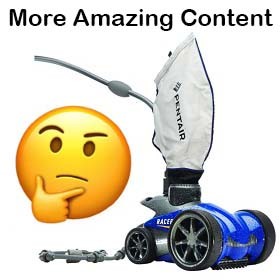
Above ground DE pool filter runner-up / honorable mention
Next, I would recommend the Hayward EC50. This model has a pump handle for prolonging the life of the D.E. The EC50 would be a good fit for the following pool sizes. I would recommend comparing pricing from Amazon.com, and our store.
- 18′ round
- 21′ round
- 24′ round
- 15′ x 30′ oval
For bigger above ground pools, I would like to see you go with the Hayward EC60 or EC65. They are extremely durable and will maintain any pool with ease. They also have the pump handle. I had an EC50 on my 16×32 inground pool for over 17 years. Sure it required cleaning and backwashing a bit more, but it did a great job, especially after spring clean up.
Above Ground Cartridge Filters
We by an off brand filter called Reliant, and put a 100 square foot Unicel cartridge in it, and package it with a 2-speed pump, and premium hoses, with valves all for only $350.00. 100 sqft cartridge filter system
The Reliant is enough for most above ground size pool. I would run it on low speed 24 hours a day.
Inground Cartridge Filter Recommendations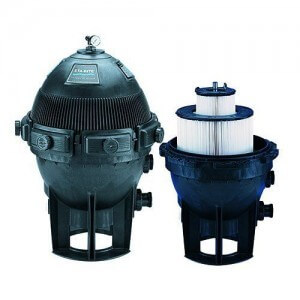
I only recommend one in this category. The Sta-Rite S8M150 (seen on the right). This filter is very efficient and requires very little regular maintenance.
One Caveat: This is a poor choice for those with two-speed pumps, as it requires a minimum pump speed of 50GPM. Which means you would always have to run your pump on high. It would be better matched with a variable speed pump where you could dial the gallons per minute (GPM) right to 50.
Inground Sand Filters
The Hayward S310T2 Pro-Series 30-Inch Top-Mount Pool Sand Filter holds 500 lbs of sand and will maintain in-ground pools up to 40,000 gallons. It could be considered overkill for a 16′ x 32′ or smaller pool, but it cost about the same as a Hayward S200 and holds 300lbs more media (extreme value).
Inground D.E Filters.
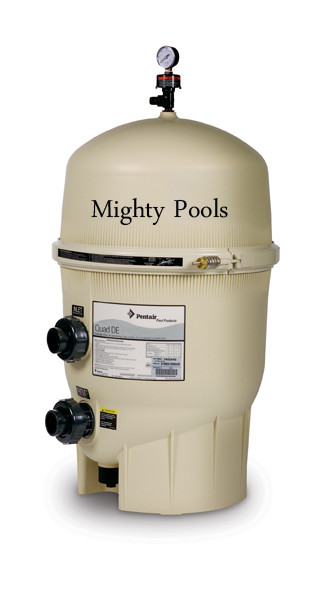
I am a huge fan of Pentair in-ground D.E filters. Especially the DE Quad Pro 60 and 80 models. It will maintain any residential in-ground pools. When shopping, remember, the bigger the square footage, the bigger the clean. I shot the video below in 2016.
Pool Filter Reviews Conclusion
Choosing the right filter will save you a ton time and headaches over the coming years. I hope this article will help you to spend more time in your pool, and less time cleaning and working on it. Keeping a pool clean is simple, keep your pool filter clean and keep your pool water balanced. I maintain 100s of swimming pools with a quick 20-30 minute visit once a week; you have the benefit of living where the only pool you have to take care is located. Owning a swimming pool is a privilege and a luxury, buy some good equipment once, and you will be glad you did!
If you liked this article, you might also like to read:
Please ask any questions, or add your opinion in the comments below. Thanks!
